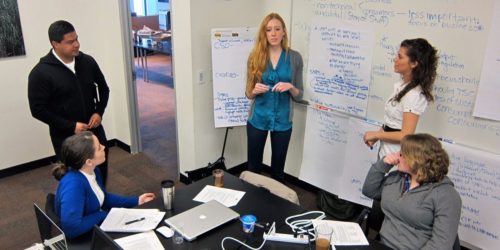Millennials, Collaboration, Meetings and More in Today’s Workforce

We all talk about collaboration in the industry, in fact numerous manufacturers as well as integrators have put grand focus to it and that’s all well and good – collaboration is certainly an important element of every day progress in the business world. It may involve certain industry solutions, it may just focus on communication and idea sharing itself. However we may well be looking past something else where collaboration takes place in one way or another, which also occurs on a daily basis and drives the business world (both positively and negatively) – and that’s the meeting. Add to that the fact that Millennials have already become major generational players in the workforce and this builds out to a much larger conversation now.
According to a Workflow blog Three Ways Millennials Want to Communicate:
Millennials make up 34% of today’s workforce and, according to the U.S. Census Bureau of Labor Statistics, will comprise nearly half the workforce by 2020. While business decision makers may be hesitant to upend existing technologies and process around this shift, the fact is that this generation works differently than its predecessors, and understanding these differences is key to equipping millennials with the right tools to maximize productivity and efficiency.
So let me think for a second here – dinosaurs will continue to be dinosaurs unless they wake up to the fact that Millennials have already begun to influence the workforce and by 2020 will in effect begin to dominate it? As well as the fact that this generation actually has its own way of getting things done compared to previous generations?
Do you think this never-ending post-Gen X discussion has gone on long enough already? I’ll bet they do – in fact I believe if Millennials had a chance to vote, like Gen Z did in choosing The Founders, they’d create their own unique name and cast the mostly negative identifier into the wind in a heartbeat.
The first strategy pointed out in the blog is about helping them prioritize communications, stating that Millennials are very comfortable toggling between numerous applications on their mobile devices, whether they are employer-sanctioned or BYOD. Then there’s mention of how many employees are “going rogue” when it comes to the apps and services they use for business communications and collaboration. Are we referring to shadow IT here? Then the talk of how all of these applications threaten to increase worker distractions and decrease productivity.
So now – the World Economic Forum tells us all how to be more productive in 2016 (which extends to Business Insider‘s “13 bad habits you should break in 2016 to be more productive”) and I say does this only refer to Millennials and not the rest of us? Well if you do take a look at the BI article, youll see the images are all indeed Millennials. No way at all do Gen Xer’s (and your handful of Boomers) spend time surfing the web, constantly checking e-mail, going in and out of meetings, etc. Oh I see, there is no hope for us as all is already lost. On to make the Millennials successful. Or drive them out of their minds, whichever comes first.
This is my favorite by the way: Constant internet access can also lead people to check email throughout the day. Sadly, each time you do this, you lose up to 25 minutes of work time. What’s more, the constant checking of email makes you dumber. I check e-mail every morning still so they don’t doubly pile up by lunchtime. Haven’t lost an IQ point yet.
Actually, I do agree that the business world needs to do more to tailor communications, collaboration, meetings and more for them. The blog goes on to specify how contextual unified communications and collaboration, for example, presents each worker with a single interface pane to manage and interact with the conversations, files, images and other resources most relevant to the task at hand. With this Millennials can use the apps and services they’re most comfortable with, while reducing distractions and the loss of productivity resulting from failed attempts to multitask.
Hmm, we may be on to something here.
The next point in fact involves limiting meetings where manpower consultants from Bain & Company, a global management consulting firm, determined that 300,000 hours a year were estimated to be lost by one large firm as a result of just one weekly executive meeting.

While people have been questioning the usefulness of meetings for years now, the problem has only continued to get worse where in a Harvard Business Review article, Michael Mankins, a partner in Bain’s San Francisco office, writes, “15% of an organization’s collective time is spent in meetings—a percentage that has increased every year since 2008.”
It appears that better “collaboration tools” – those that can actually be deemed to provide true productivity and efficiency – could well be an answer here as meetings can prove to become more effective. Nureva Span provides an interesting example of ideation vs. collaboration and Oblong is another with their Mezzanine immersive workspace solution.
Giving people further ability to be on their PC’s, being more productive from their offices (company or home) in meetings, as well as on devices putting them on the road where they can increase a business’s bottom line by also scheduling client appointments – which obviously can’t be done while stuck in the office conference room (huddle space, etc.) having meetings.
When we talk about collaboration and productivity enhancement, I’ve gone as far as to say we stop labeling them as just collaboration solutions and refer to those that actually step up the game as being productivity solutions (to create a brand new industry buzz term). Take Slack or Cisco Spark for example – I hardly call those just collaboration as much as productivity applications which fully describes the intended end result, less e-mail, instant intercation, etc. Box (like Barco Clickshare), as well as software-based solutions (like Mersive Solstice) can enrich the meeting experience and videoconferencing (cloud and on-prem solutions) gives one numerous types of communication and collaboration capabilities that can best fit an organization’s targeted needs.

Enabling seamless mobility is the last point in the blog where it’s been specified that over 85 percent of millennials have an iPhone or Android smartphone, and it is often their primary device. Yes that’s right – they live on their devices. Heck, so do I and I border on the far edge of Gen X. You can see me on my laptop, iPad or Android phone most of the day and on my office PC whenever I need to be. The blog states that Millennials expect seamless communications as they move from one device to another.
Take note, this is one of the truer statements as we take hard looks at collaboration now. A good mass of Gen X’ers (and even some Boomers) today expect it too.
In a Microsoft in Business blog Cloud, Collaboration and Today’s Workforce, Vahé Torossian, Corporate VP, Microsoft Worldwide Small and Midmarket Solutions and Partners (SMS&P) states that no matter the industry, businesses of all sizes are prioritizing having modern infrastructure, easy-to-use tools and programs for their workers, best-in-class devices and making things easy for their customers. He goes on to specify that truly digital businesses share a common trait: they collaborate differently. It’s also pointed out how modern workers spend the majority of their day interfacing with technology, where in turn antiquated tools can be detrimental to their job satisfaction. A recent survey conducted by Microsoft showed that Millennials in the workforce demand adequate technology to do their jobs where more than 90 percent of respondents said the latest technology was important in choosing an employer.
In the end, we must consider certain tools for communication, collaboration and productivity and how they can become joined solutions concepts in the corporate environment’s physical and human infrastructure, which can then lead to creating the ultimate experience for the workforce – Millennials and the rest.
And where those meetings are concerned, beyond enhancing collaboration capabilities, as discussed it is also highly beneficial to focus on reducing meetings and even meeting time. Read this and you may just have an answer for that too.



